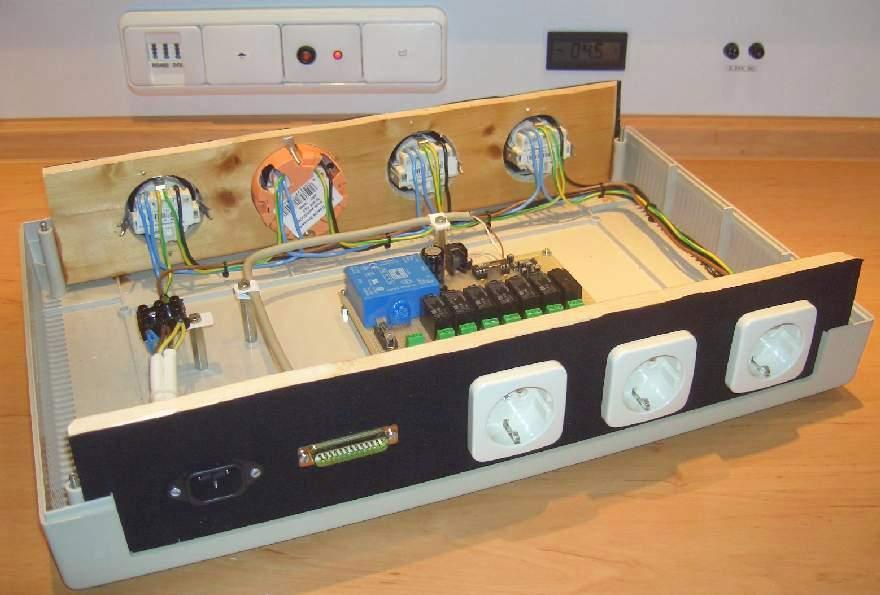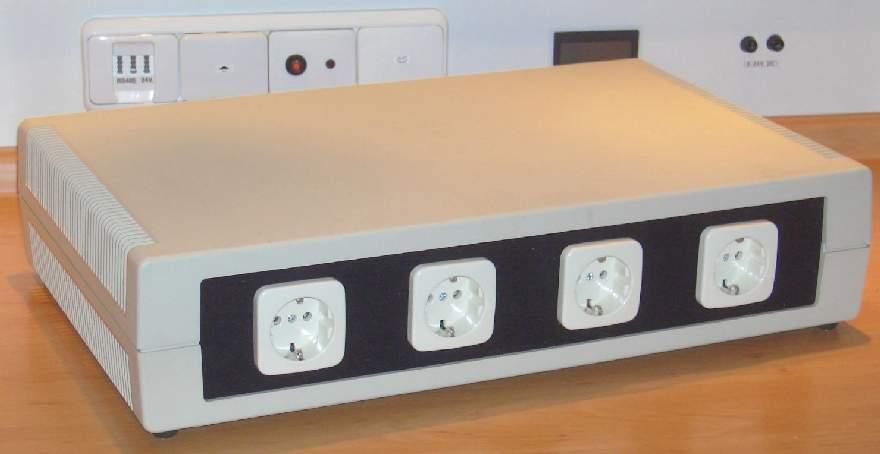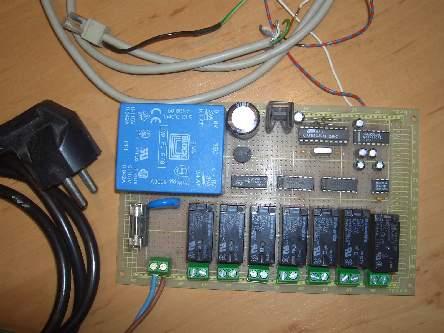VMS Wall Socket RC
A relay array controlled via a serial interface
for operating power outlets for peripheral devices which are not needed permanently, was the result of considerations after having forgotten to do a backup.
Since a tape drive is rarely needed around the clock in a private IT environment it usually will be switched off after having been used. Consequently, cyclic and fully automated batch operations are impossible without manual intervention, which in this case means switching on the tape drive.
The computer as an event-driven switch
Hence a solution had to be implemented which provides for the devices being switched on and off as needed by the computer itself. In particular at the time when a program or procedure is started. An unused serial interface was found and an idea sparked: The serial interface could be abused for controlling some relays which would feed (or not) power to corresponding outlets.
A small power supply, a simple processor, a serial receiver, an amplifier and a bit of TTL-logic for inverting the output signals as well as a monitor for the supply voltage seemed to be sufficient for making the idea come real.
The circuitry
first was tested using a breadboard,
Hence a solution had to be implemented which provides for the devices being switched on and off as needed by the computer itself. In particular at the time when a program or procedure is started. An unused serial interface was found and an idea sparked: The serial interface could be abused for controlling some relays which would feed (or not) power to corresponding outlets.
A small power supply, a simple processor, a serial receiver, an amplifier and a bit of TTL-logic for inverting the output signals as well as a monitor for the supply voltage seemed to be sufficient for making the idea come real.
The circuitry
first was tested using a breadboard,
after the processor (Atmel 89C2051, a PEROM featuring a 8-bit CPU and 2k Flash)
had been loaded with a suitable program written in Assembler. A MAX232 was used
for the serial interface which provides the processor with the required TTL
output level. The processor's output is inverted by a 74HC14 and amplified by
a ULN2003 (7 Darlington rows) and then fed to the relays.
An ADM705 monitors the supply voltage and provides for a corresponding reset signal for the processor.
A transformer, a rectifier and an E-CAP as well as a 7805 were used for a 5V supply, which meets the usual procedure for such cases.
An ADM705 monitors the supply voltage and provides for a corresponding reset signal for the processor.
A transformer, a rectifier and an E-CAP as well as a 7805 were used for a 5V supply, which meets the usual procedure for such cases.
A first test
after the board had been assembled was done under real conditions - at least from the computer's point of view, but was more of a hoax, though.
The relays' inputs were fed with a voltage of 14V AC and suitable bulbs were connected to the relays' outputs. The lights' circular arrangement provides for a nice effect which you can see in the demonstration on the left.
Controlling the lights was done with a little DCL procedure, which demonstrates the simplicity of the commands required for this purpose. Just two bytes are required to accomplish the trick...
Display larger video
after the board had been assembled was done under real conditions - at least from the computer's point of view, but was more of a hoax, though.
The relays' inputs were fed with a voltage of 14V AC and suitable bulbs were connected to the relays' outputs. The lights' circular arrangement provides for a nice effect which you can see in the demonstration on the left.
Controlling the lights was done with a little DCL procedure, which demonstrates the simplicity of the commands required for this purpose. Just two bytes are required to accomplish the trick...
Display larger video
Purposes of use
for this device are numerous given it features a design with potential-free and galvanically isolated contacts. On the one hand there are the peripheral devices mentioned above which can be switched on and off as needed and on the other one could think of applications like illumination in and around the house or playful things like ringing a bell on the occurance of some event the computer is able to capture.

Wiring completed - Rear view (or front view - depends upon POV)
The housings of old DEC network components always had been grateful victims for abuse and so an old DECserver 200's housing was used a new home for the board and the sockets.
A 10A power outlet for non-heating apparatuses, a 25pin Sub-D plug and wire with a cross section of 1.5mm2 and a few nuts and bolts were in stock so that it took next to no time to builtup the device.

The opposite side
First, the backup procedure had been modified so that the tape drive is powered in the moment it's needed...
for this device are numerous given it features a design with potential-free and galvanically isolated contacts. On the one hand there are the peripheral devices mentioned above which can be switched on and off as needed and on the other one could think of applications like illumination in and around the house or playful things like ringing a bell on the occurance of some event the computer is able to capture.
Ready for operation
During an unplanned ad hoc nightshift I decided to refrain from playful things and to instead connect the peripherals inside the computer cabinet (tape drive, flatbed scanner, printer, terminal server, DCF77 clock and a punch tape reader/ printer) for having these switched on and off by the computer.
Wiring completed - Rear view (or front view - depends upon POV)
The housings of old DEC network components always had been grateful victims for abuse and so an old DECserver 200's housing was used a new home for the board and the sockets.
A 10A power outlet for non-heating apparatuses, a 25pin Sub-D plug and wire with a cross section of 1.5mm2 and a few nuts and bolts were in stock so that it took next to no time to builtup the device.

The opposite side
First, the backup procedure had been modified so that the tape drive is powered in the moment it's needed...


